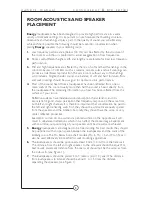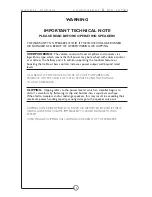
ROOM ACOUSTICS AND SPEAKER
PLACEMENT
Energy
loudspeakers have been designed to provide high performance in a wide
variety of domestic settings. It is important to note however, that building structure,
dimensions and furnishings all play a part in the quality of sound you will ultimately
achieve. Where possible the following should be taken into consideration when
placing
Energy
speakers in your listening room:
1.
Low frequency performance (below 100 Hz) can be affected by the structure of
the room. A solid floor is preferred to avoid exaggeration of low frequencies.
2.
Rooms with different height, width and length are preferable for best low frequency
performance.
3.
Mid and high frequencies are affected by the mix of soft and hard furnishings in the
room. An excess of soft items such as curtains, carpets, sofas and wall coverings can
produce a dull, lifeless reproduction.The same room without any soft furnishings
will produce a brighter, harder sound, so a balance of soft and hard furniture, floor
and wall coverings should be your goal for optimum sonic performance.
4.
Most of the sound heard from a loudspeaker has been reflected from one or
more walls of the room. Usually, more than half the sound is heard directly from
the loudspeaker.The remaining information you hear has been reflected from the
surfaces of your room.
Reflective surfaces have individual sound absorption characteristics, and it is
important for good stereo perception that frequency response be the same from
both left and right channels. It is therefore important that consideration be paid to
the left and right reflecting walls. First, they should be symmetrical, equally spaced
from the speakers and the listeners. Secondly, they should have the same, or very
similar reflective properties.
Example: A curtain on one wall and a painted surface on the opposite wall will
result in unbalanced reflections, which in turn affect the stereo image. Experiment
with toe-in/toe-out positioning of your speakers until best results are achieved.
5. Energy
loudspeakers are designed to be free standing. For best results they should
be positioned with an open space between the loudspeakers and the walls of the
listening room.The Pro Series book shelf models (Pro .5, Pro 1.5 and Pro 3.5) can
also be used effectively in bookshelf or wall mounting applications.
6.
The loudspeakers should be positioned at least 30cm (12 in.) from the back wall.
The distance from the left and right speaker to the side walls should be equal. For
best results, placement distance from the rear wall should not be the same as from
the side walls. (see Figure 1).
7.
The loudspeakers should be placed 2 to 3 meters (6’ to 10’) apart.The distance
from loudspeakers to listener should be about 1 to 1.5 times the distance
separating the speakers. (see Figure 1).
o w n e r s m a n u a l
c o n n o i s s e u r & p r o s e r i e s
3






























